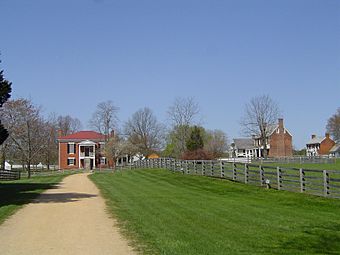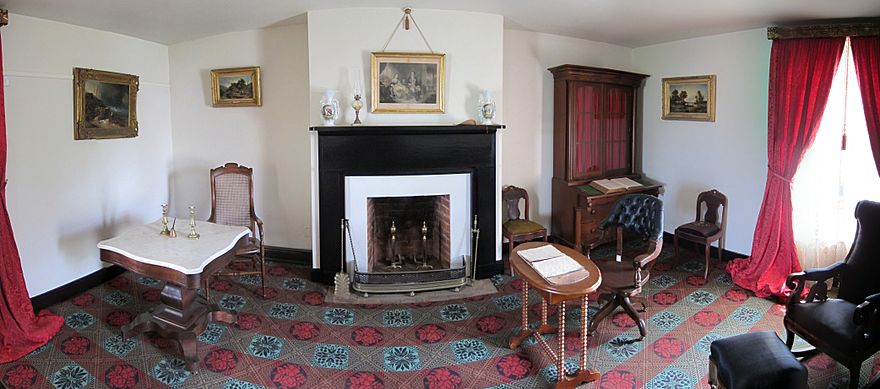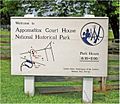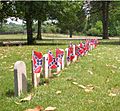Appomattox Court House facts for kids
|
Appomattox Court House National Historical Park
|
|

Appomattox Court House National Historical Park. The Old Appomattox Court House is at left; the reconstructed McLean House, the site of the formal surrender, is at right.
|
|
| Location | Appomattox County, Virginia |
|---|---|
| Nearest city | Appomattox, Virginia |
| Area | 1,774.6 acres (718.2 ha) |
| Visitation | 92,650 (2021) |
| Website | Appomattox Court House National Historical Park |
| NRHP reference No. | 66000827 |
Quick facts for kids Significant dates |
|
| Added to NRHP | October 15, 1966 |
The Appomattox Court House National Historical Park is a special place in Appomattox County, Virginia. It is a preserved 19th-century village. This village is famous as the site of the Battle of Appomattox Court House. It also contains the McLean House. This is where General Robert E. Lee of the Army of Northern Virginia surrendered. He surrendered to Union commander Ulysses S. Grant. This important event happened on April 9, 1865. It is seen as the symbolic end of the American Civil War.
The village started as a community called Clover Hill. It became the county seat for Appomattox County in the 1840s. However, the village began to decline after 1854. This was because a railroad was built that bypassed it. In 1930, the U.S. War Department was allowed to build a monument here. By 1933, the National Park Service took over the site. The park grew much larger in 1935. Plans to restore the McLean House were delayed by World War II. Finally, in 1949, the restored McLean House opened to the public. Today, the park has several restored buildings, like the McLean House and the courthouse. It also has many original 19th-century structures.
Contents
How the Village Began
From Clover Hill to County Seat
The village we know today as Appomattox Court House started as "Clover Hill." It was a stop along the busy Richmond-Lynchburg stagecoach road. People also held important meetings here. So, when Appomattox County was created on February 8, 1845, Clover Hill became its main town, or county seat. The new county was formed from parts of several other counties. It was named after the Appomattox River, which flows from nearby. The name "Appomattox" likely came from the Apumetec Native American tribe.
Around 1842, a man named Hugh Raine owned most of the Clover Hill area. After the county was established, about 30 acres (12 ha) of the village were divided into town lots. The state set aside 2 acres (0.81 ha) for government buildings. The courthouse was planned to be built across the Stage Road from the Clover Hill Tavern. The jail was to be behind the courthouse.
Why the Village Declined
In late 1845, Hugh Raine sold the Clover Hill area to Samuel D. McDearmon. McDearmon tried to sell the lots, but it was difficult. The village did grow a bit. However, in 1854, a railroad was built through nearby Appomattox Depot. Many businesses moved from Appomattox Court House to the new railroad area. Around the same time, the stagecoach route to Appomattox Court House stopped. This caused the village to begin its decline.
The End of the Civil War
Lee's Surrender at Appomattox
In early April 1865, the American Civil War was nearing its end. Confederate States Army forces, led by General Robert E. Lee, were being chased. They were pursued by Union Army troops under Lieutenant General Ulysses S. Grant. Lee's troops were trapped at Appomattox Court House. They attacked on April 9 in the Battle of Appomattox Court House, but they were not successful.
On that same day, General Lee met with General Grant. They met to discuss the terms of surrender at the McLean House. After talking, Lee signed the surrender terms that day. Three days later, on April 12, the Confederate Army of Northern Virginia laid down its weapons. They then marched away. Even though the war continued in other places for a short time, the surrender at Appomattox Court House became a powerful symbol. It showed that the Confederacy was defeated.
After the War: More Decline
The end of the war did not stop the village's decline. In 1892, the county's important records were destroyed in a courthouse fire. Because of this, officials decided to move the county seat. They moved it to the railroad community at Appomattox Depot. This new location then became the town of Appomattox.
Creating the Historical Park
How the Park Was Established
In 1892, after the courthouse burned and the McLean House was taken apart, George B. Davis learned about the village's poor condition. He got permission to place metal markers at important historical spots. In 1930, the United States Congress passed a law. It allowed the U.S. War Department to buy land in the village for a monument. This monument would honor the 1865 surrender.
Three years later, in 1933, the National Park Service took over the War Department's land. The site's name changed in 1935. It went from "Appomattox Battlefield Site" to "Appomattox Court House National Historical Monument." This change was part of a law that made the park bigger. It also allowed the McLean House to be rebuilt. The name changed again in 1954 to "Appomattox Court House National Historical Park."
Park Growth and Restoration
By 1940, the park grew to 970 acres (390 ha). A plan was made to rebuild both the courthouse and the McLean House. However, World War II caused delays in the reconstruction. Finally, in 1949, the restored McLean House opened to the public. On October 15, 1966, the park was added to the National Register of Historic Places.
The National Park Service has since restored the village. Many original 19th-century buildings still stand, like the Clover Hill Tavern. Besides these original structures, the park also has reconstructed historic buildings. This includes the famous McLean House. The park covers about 1,700 acres (690 ha). Visitors can explore it using a driving tour path or hiking trails. Along the trails, you'll find signs explaining the history. You can also see the location of Lee's headquarters and an artillery park with cannons. The park's visitor center is located in the rebuilt courthouse.
Images for kids
See also










